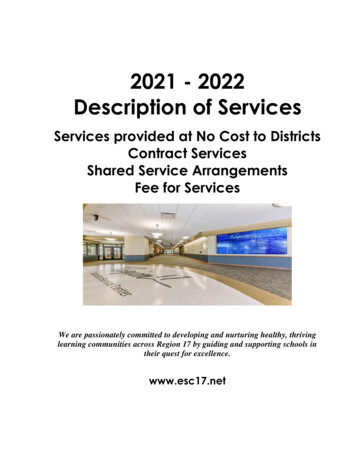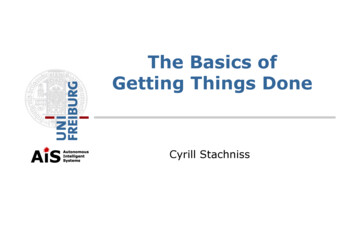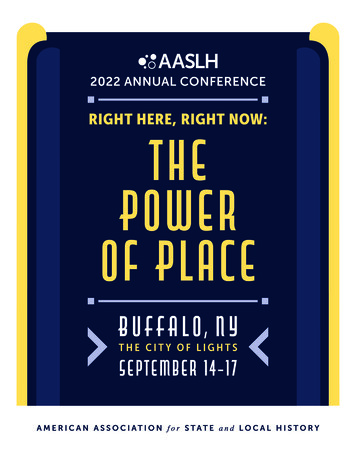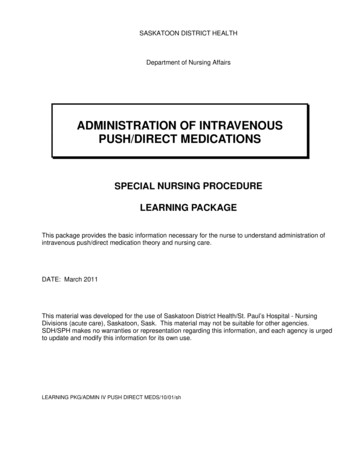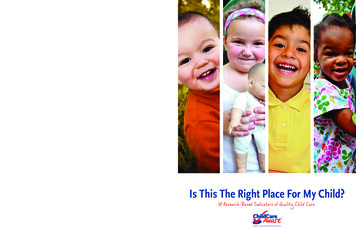
Transcription
For additional resources or help finding your localChild Care Resource and Referral Agency call toll-free:1-800-424-2246 TTY: 866-278-9428 www.ChildCareAware.orgChild Care Aware of America1515 N. Courthouse Road, Arlington, VA 22201Phone (703) 341-4100 Fax (703) 341-4101 www.usa.childcareaware.org #1819-1008 #121eIs This The Right Place For My Child?38 Research-Based Indicators of Quality Child Care
Is This The Right Place For My Child?38 Research-Based Indicators of Quality Child Care
AcknowledgementsThese indicators were created by building upon the Thirteen Indicators of Quality Child Care developed by Dr. Richard Fiene ofThe Pennsylvania State University.About Child Care Aware Child Care Aware is a program of Child Care Aware of America. We are committed to helping parents find the best informationon locating quality child care and child care resources in their community. Child Care Aware , in partnership with local Child CareResource and Referral agencies, builds consumer awareness and supports families in making choices for the care and education oftheir children. Child Care Aware is partly funded by the Office of Child Care (OCC), Administration for Children and Families (ACF),U.S. Department of Health and Human Services.Copyright 2015 by Child Care Aware of America. All rights reserved. No part of this publication may be reproduced in any form –except in case of brief quotations embodied in critical articles or reviews – without prior written permission from Child Care Aware of America.
Is This The Right Place For My Child?38 Research-Based Indicators of Quality Child Care (Checklist for Parents)Choosing Child CareChoosing care for your child while you work or attend school isone of the most important decisions you will make as a parent.Unfortunately in most areas there isn’t a “consumer report” onthe best care available. Child Care Aware of America throughChild Care Aware , helps parents find licensed care (www.childcareaware.org). Because licensing and regulations vary widely,parents need more information to make informed decisions. Thisguide helps parents understand how to better judge quality.In addition, some states have quality rating systems to helpparents with this decision. Parents can learn if their state hasa quality rating system by visiting the QRIS National LearningNetwork at qrisnetwork.org. You may also contact your local ChildCare Resource & Referral agency (CCR&R) for information.The National Association for the Education of Young Children(NAEYC) provides a list of their accredited child care centers ontheir website, www.naeyc.org, as does the National AccreditationCommission (NAC) for Early Care and Education Programs atwww.earlylearningleaders.org, and the National Early ChildhoodProgram Accreditation (NECPA) at www.necpa.net. The NationalAssociation for Family Child Care (NAFCC) lists accreditedfamily child care providers at www.nafcc.org. However, only asmall percentage of child care programs in the United Statesare accredited by any organization or are part of a quality ratingsystem.After using these and other resources, parents should visit theprograms they are considering. Included in this publication isa checklist parents can use to evaluate child care programs.This checklist is based on research on what is important tochildren’s health, safety and development. Following thechecklist are suggested ways to find the information you areseeking. Quality programs will want you to have all the informationyou need to choose the best child care for your child and family.Child Care Aware of America produced this guide to help parentswith their search for quality child care.Is This the Right Place for My Child? 38 Research-Based Indicators of Quality Child Care3
The Quality Indicators listed in this guide are based onresearch about what is important in order for children to beprotected and well cared for in a group child care setting.Each indicator is followed by a short explanation of why it isimportant. This is followed by what to look for and ask to learnif the program you are considering will be a safe, healthy andhappy place for your child. The term “director” is used to referto the person in charge of a child care center or the provideroperating a family child care home. The term “program staff”is used to refer to individuals providing care in centers or familychild care homes. It isn’t necessary to ask all of the questions ormake all of the observations suggested; they are only providedas a resource to help you evaluate the programs you areconsidering for your child.4Child Care Aware of America, is our nation’s leading voicefor child care. We work with more than 400 state and localChild Care Resource and Referral agencies (CCR&Rs) toensure that families in every community have access to quality,affordable child care. To achieve our mission, we lead projectsthat increase the quality and availability of child care, offercomprehensive training to child care professionals, undertakegroundbreaking research, and advocate child care policies thatpositively impact the lives of children and families.Is This the Right Place for My Child? 38 Research-Based Indicators of Quality Child Care
Is This The Right Place For My Child?(Make a copy of this checklist to use with each program you visit.)Place a check in the box if the program meets your expectations.Will my child be supervised?Are children watched at all times, including when they are sleeping?15Are adults warm and welcoming? Do they pay individual attention to eachchild?40Are positive guidance techniques used?Do adults avoid yelling, spanking, and other negative punishments?16Are the caregiver/teacher-to-child ratios appropriate and do they followthe recommended guidelines: One caregiver per 3 or 4 infantsOne caregiver per 3 or 4 young toddlersOne caregiver per 4 to 6 older toddlersOne caregiver per 6 to 9 preschoolers19Have the adults been trained to care for children?If a center, Does the director have a degree and some experience in caring or children? 27/28/29 Do the teachers have a credential*** or associate degree and experience in caringfor children?27/28/29If a family child care home: H as the provider had specific training on children’s development and experiencecaring for children?30Is there always someone present who has current CPR and first aid training?32Are the adults continuing to receive training on caring for children?33Have the adults been trained on child abuse prevention and how to reportsuspected cases?12/13Will my child be able to grow and learn?For older children, are there specific areas for different kinds of play (books,blocks, puzzles, art, etc.)?21For infants and toddlers, are there toys that “do something” when the child playswith them?41Is the play space organized and are materials easy-to-use? Are some materialsavailable at all times?21Are there daily or weekly activity plans available? Have the adults plannedexperiences for the children to enjoy? Will the activities help children learn?22Do the adults talk with the children during the day? Do they engage them inconversations and ask questions, when appropriate?43Do the adults read to children at least twice a day or encourage them to read,if they can do so?43Is this a safe and healthy place for my child?Do adults and children wash their hands (before eating or handling food, orafter using the bathroom, changing diapers, touching body fluids, eating, etc.)?4Are diaper changing surfaces cleaned and disinfected after each use?5Do all of the children enrolled have the required immunizations?6Are medicines labeled and out of children’s reach? 7Are adults trained to give medicines and keep records of medications? 7Notes:
Place a check in the box if the program meets your expectations.Are cleaning supplies and other poisonous materials locked up, out ofchildren’s reach?8Notes:Is there a plan to follow if a child is injured, sick or lost?9Are first aid kits readily available? 10Is there a plan for responding to disasters (fire, flood, etc.)?11Has a satisfactory criminal history background check been conducted on eachadult present? Was the check based on fingerprints?14Have all the adults who are left alone with children had background andcriminal screenings?13Is the outdoor play area a safe place for children to play?39 Is it checked each morning for hazards before children use it?23 I s the equipment the right size and type for the age ofthe children who use it?24 In center-based programs, is the playground area surroundedby a fence at least 4 feet tall?25 Is the equipment placed on mulch, sand, or rubber matting?23 Is the equipment in good condition?39Is the number of children in each group limited? I n family child care homes and centers, children are in groupsof no more than** 6-8 infants 6-12 younger toddlers 8-12 older toddlers 12-20 preschoolers 20-24 school-agers20Is the program well-managed?Does the program have the highest level of licensing offered by the state?42Are there written personnel policies and job descriptions?17Are parents and staff asked to evaluate the program?37Are staff evaluated each year, and do providers complete a self-assessment?18Is there a written annual training plan for staff professional development?33Is the program evaluated each year by someone outside the program?38Is the program accredited by a national organization?36Does the program work with parents?Will I be welcome any time my child is in care?1Is parents’ feedback sought and used in making program improvements?1Will I be given a copy of the program’s policies?2Are annual conferences held with parents?3* These are the adult-to-child ratios and group sizes recommended by the National Association for the Educationof Young Children. Ratios are lowered when there are one or more children who may need additional help to fullyparticipate in a program due to a disability or other factors.** Group sizes are considered the maximum number of children to be in a group, regardless of the numberof adult staff.*** Individuals working in child care can earn a Child Development Associate credential.For help finding child care in your area, contact Child Care Aware , a program of Child Care Aware of Americatoll-free at 1-800-424-2246 or visit online at www.childcareaware.org.For information about other AAP publications visit: www.aap.orgEndorsed by:
Is This the Right Place For My Child?Will my child be supervised? Are childrenwatched at all times, including when theyare sleeping? 15If your child is supervised at all times he or she is less likely tobe injured, as well as more likely to be engaged in activities thatpromote learning. It is especially important that caregivers checkon infants while they are sleeping because of the risk of SuddenInfant Death Syndrome (SIDS). Also, if adults closely supervisechildren outdoors, children are less likely to be injured. Observe the program staff when the children are outdoors.Do the adults stay close to the children and intervene whenchildren engage in risky activities? If possible, visit the program when children are resting orsleeping as well as when they are awake. During rest timeare the children where the adults can see them? Do theadults check on the children frequently?Are adults warm and welcoming? Do they payindividual attention to each child?Children grow and learn when they feel cared about andcomfortable. When adults pay attention to children they canrespond to their individual needs, extend their learning, engagethem in activities, and offer materials and information.Observe the adults: Do they smile and talk to you? Do they smile and talkto your child? How do they act with the other children? Do they interact with individual children as well as thegroup of children? Do they respond when children make requests? Do they offer materials and information to extendchildren’s play? Do they encourage and support children’s efforts? Do they comfort children who need to be comforted?Is This the Right Place for My Child? 38 Research-Based Indicators of Quality Child Care7
Are positive guidance techniques used?Do adults avoid yelling, spanking, and othernegative punishments? 16When each adult is responsible for fewer children, your child canbe provided with more one-on-one attention. Attention is crucialto your child’s social and emotional development. It also helpsadults get to know your child and plan activities based on hisor her learning needs and interests. (In some states, programsare allowed to have each adult care for more children while thechildren are asleep or resting.)Children learn how to behave through adult example andencouragement. Positive guidance techniques include: Setting limits for the child. “Keep the paint on the paper.” Giving reasons for rules and limits. “If you eat lunch nowyou won’t be hungry later.” Changing something about the situation. For example,moving a breakable item out of a toddler’s reach.In child care centers, children are in groups of no more than: Six to eight infants Redirecting the child’s behavior. “Ride your bike on thepath, not on the grass.” Six to 12 younger toddlers Using consequences. “If you leave the paint out you won’tbe able to use it tomorrow.”Yelling, spanking, and other negative punishments provide a badexample for children and may harm the child in other ways. Ask the program director to see the program’sguidance policies. Look for prohibitions against negativepunishments and examples of positive techniques such asthose listed above. Observe the program staff to see what techniques theyuse when children misbehave. Watch for use of negativepunishments (yelling, hitting, twisting arms, ridiculing,criticizing, threatening, etc.). Expect to see the positivetechniques listed above. Ask the program staff, “What do you do when childrendon’t follow the rules?” and “What do you do whenchildren misbehave?” and “How are children punishedwhen they don’t behave?” Ask the program staff, “How is time out used?” Expectto hear that time out is used to help children relax, not asa punishment. One caregiver per three or four infants One caregiver per three or four young toddlers One caregiver per four to six older toddlers Observe to see how many children each adult is providingcare for during the day.Is the number of children in each group limited? Ignoring behavior when it is appropriate to do so.For example, not responding when a child whines forsomething he or she wants.Are the caregiver/teacher-to-child ratiosappropriate and do they follow theserecommended guidelines?Ask the program director, “How many children is eachadult responsible for?” Compare his or her answer tothe information above. Eight to 12 older toddlers Twelve to 20 preschoolers Twenty to 24 school-age children20Small group sizes ensure your child will receive one-on-oneattention and is part of a group that is easier to manage. Smallgroup sizes are particularly important for young children whoneed more individual attention and can become overwhelmedin large groups. Ask the program director how many children are in eachgroup. Compare the answers to the information above. Observe to see the size of the groups in whichchildren receive care. Compare the group sizes to theinformation above. If the group in which your child will receive care includesone or more children with special needs, look to see if theprogram has adjusted the number of children in the groupso that all of the children’s needs are met.Have the adults been trained to carefor children?If a center: Does the director have a degree and some experience incaring for children? 26 Do the teachers each have a credential or associate degreeand experience in caring for children?27/28/29 One caregiver per six to nine preschoolers198Is This the Right Place for My Child? 38 Research-Based Indicators of Quality Child Care
If a family child care home:have an associate degree in early childhood education ora related field? How many of them have their CDA (ChildDevelopment Associate credential)? Has the provider had specific training on children’sdevelopment and experience caring for children?30Staff education is the best predictor of the quality of an earlychildhood program. Adults with training in early childhoodeducation provide higher quality programs for your child,implement more appropriate activities, and do a better job ofpreparing your child for school.Managing a child care program is a challenging task thatrequires both early childhood and business managementknowledge. Experience putting this knowledge to work enhancesthe child care program’s quality.Experience helps adults gain knowledge of early childhoodprograms and effective strategies for caring for and educatingyour child. Experience, combined with training and education,increases the quality of early childhood programs. Ask the family child care provider, “How much traininghave you had in early childhood education? Did thetraining include information on the development ofchildren’s social and emotional behavior, thinking, andlanguage?” and “How many years of experience do youhave providing child care?”Is there always someone present who has currentCPR and first aid training? 32If adults are trained in emergency first aid and infant/toddlerCPR they will know how to handle medical emergencies andreact appropriately in case your child has a medical emergency. Ask the center director, “Do you have a college degree?”and “What field is your degree in?” Listen for earlychildhood education, child development or a related field. Ask the program director, “Who in the program hascurrent certification in CPR and first aid?” and “Is therealways someone on duty in the program with currentcertification in CPR and first aid?” Ask the center director, “How much experience do youhave managing a child care program?” Check the program’s job descriptions to find out ifcertification in CPR and first aid are required. Ask the center director, “How many staff members doyou have? How many of them have a degree in earlychildhood education or a related field? How many of them Ask to see copies of the program staff’s or provider’sfirst aid and CPR cards.Is This the Right Place for My Child? 38 Research-Based Indicators of Quality Child Care9
Are the adults continuing to receive training oncaring for children? 33If the adults caring for your child continue to receive training,they will know new information about how to protect your child’shealth and safety, for example, how to reduce the incidence ofSudden Infant Death Syndrome (SIDS). They will also know howto promote children’s development, for example, the newestresearch on how children learn to read and write. Ask the program staff, “When was the last time youattended training on early childhood education?” Ask the program director, “Are staff required to attendtraining each year?” and “Are staff funded to attend trainingeach year?” Review the program’s annual training plan to find out howmuch training staff members or providers receive each year.Have the adults been trained on child abuseprevention and how to report suspectedchild abuse? 13Will my child be able to grow and learn?For children age 3 and older, are there specificareas for different kinds of play (books, blocks,puzzles, art materials, etc.)? 21Your child will learn different concepts and skills in differentinterest areas (blocks, books, puzzles, art materials, music,science and math). Interest areas that are organized and orderlywill help your child make choices about what to play with andwhere to put materials away. The areas may have different namessuch as library (instead of books), manipulatives (instead ofpuzzles), construction (instead of blocks), etc. In a family childcare home the areas may be set up each day or left permanentlyin place. Look to see if there are areas with different kinds of toys andmaterials. Expect to see an area with books, art materials,blocks and other construction toys such as trucks, andpuzzles and other small manipulatives such as Legos. Youmay also see a science and math area and a music area.Caregivers who are trained in identifying and reporting childabuse will know how to respond if they suspect a child hasbeen mistreated. Check to see if the areas include a variety of toys and othermaterials. Ask the program staff, “Have you been trained on how toidentify and report child abuse?” and “If you suspect a childhas been abused, who would you report it to?”10 Ask the program director, “Are the staff and volunteerstrained on how to identify and report child abuse?” and“What is included in this training?” Ask the program staff, “How often do you add newmaterials to the areas or rotate the materials in theIs This the Right Place for My Child? 38 Research-Based Indicators of Quality Child Care
areas?” Expect new or different materials will be addedat least monthly. In a family child care home, look to see that infantsand toddlers are protected from small items that couldcause choking.For infants and toddlers, are there toys that “dosomething” when the child plays with them? 41Infants are interested in looking at toys, touching them with theirhands and mouth, fitting pieces of things together, and makingsense of their world.Infants need brightly colored toys of many textures. They needtoys to look at, feel, chew on, hold, and drop. As they begin towalk or crawl they enjoy push-pull toys and balls.In the second year of life, toddlers have the physical skills thatmake it easier for them to play and learn. Busy toddlers need toysfor physical play – walking, climbing, pushing and riding – andones that encourage experimentation and manipulation.For infants, look to see if the program has: Balls Grasping toys Stacking and nesting toys Toys to look at, feel, and chew onFor toddlers, look to see if the program has: Equipment for climbing Riding toys Balls Large interlocking blocks and puzzles Water and sand for sensory playIs the play space organized and are materialseasy to use? Are materials available at all times? 21If the play areas are organized and orderly your child will be ableto make choices about what materials to play with and will beable to put toys away after playing with them.Look for: Materials organized by type (blocks, puzzles, dolls, artmaterials, dress-up clothes, etc.). Spaces and containers labeled with a picture or drawing ofthe materials. Overall organization. If you were a child wanting to playdress-up or wanting to do a puzzle, would youknow where to look? Accessibility. Are some materials available at all times andeasy for children to reach?Are there daily or weekly activity plansavailable? Are there planned experiences forthe children to enjoy? Will the activities helpchildren learn? 22Children benefit when adults plan activities for them. If the dailyactivities reflect your child’s interests and needs it increasesthe likelihood your child will benefit from the experiences. Heor she will also benefit more if the activities are ones they enjoyand are planned to help them learn and develop. If the programplans a variety of activities it increases the potential that all of thechildren’s needs will be met. Ask to see the program’s daily or weekly plans. Check tosee if the plans include a variety of activities – art, music,outdoor play, reading, dramatic play, science, and math. Ask the program director, “Do you have a plannedcurriculum? If so, what is it?” Look to see if the children seem to be enjoying the activitiesthat are being offered and are actively engaged in them. Ask the program staff, “How do you decide whichactivities to offer?” Expect to hear the activities are based onthe children’s interests and needs.Do the adults talk with children during the day?Do they engage them in conversation? Do theyask questions, when appropriate?Adults can help promote children’s language development bytalking with them during the day. Research has shown that earlyexposure to language leads to greater language skills as childrengrow older. The more caregivers and parents talk to childrenwhile they are caring for and playing with them, the moreeffectively children will learn to communicate.Observe the adults with the children: Do they talk with babies and toddlers while they arehandling daily routines?Is This the Right Place for My Child? 38 Research-Based Indicators of Quality Child Care11
Do they turn babies’ sounds into words? Ask the program staff “When do you wash your handsduring the day?” and “When do you wash the children’shands?” Do they provide words to help children label things? Do they encourage toddlers to use words?Are the diaper-changing surfaces cleaned andsanitized after each use? 5 Do they add words to expand children’s vocabulary? Do they engage preschoolers and older children inconversations? Do they avoid asking older children questions to which theadult already knows the answer?Do the adults read to children at least twicea day or encourage them to read, if theycan do so?Germs can be passed easily among children, particularly at thediaper-changing table. Cleaning and disinfecting the diaperchanging surface after each change reduces the chance thatgerms will be transmitted and your child will get sick. Observe the adults. Do they clean and sanitize the diaperchanging surface with a bleach water solution and adisposable towel after changing each child?Reading aloud provides children with sounds to imitate andhelps them develop phonemic awareness (the ability to hearsounds) – an important prereading skill. Reading also helpsbuild children’s vocabulary and increases their understanding offeelings, objects, and events. When adults read to them, childrenget the message that reading is important. A child’s readingskills are important for success in school and life. Ask the program staff, “How often do you read to thechildren?” Expect to hear “at least twice day” or more.Sometimes programs read books but don’t include iton the schedule. Is the surface used for changing diapers easy to sanitize?Couches, beds, etc. cannot be easily sanitized. Are the supplies (bleach water solution/paper towels)needed to clean and sanitize the diaper-changing tablelocated near the area, but not where children can reachthem? Ask the program staff, “What procedures do you followduring diaper changing to keep children healthy?” Listenfor evidence that they sanitize the diaper-changing surface.Do all the children enrolled have the requiredimmunizations? 6 Look around for children’s books. If few or no booksare available, it may be a sign that reading is not valuedby the program.Is this a safe and healthy place for my child?Do adults and children wash their hands (beforeeating or handling food and after using thebathroom, changing diapers, touching bodilyfluids, or eating)? 4Germs can be passed easily from child to child. Washing handsoften and well reduces the chance that germs will be passedalong and that your child will get sick. Observe the adults. Do they wash the children’s hands andtheir hands after using the bathroom, changing diapers,before serving foods, after handling animals, etc.?Children who are up-to-date on their immunizations areless likely to get or pass along diseases. When all the childrenin a program are healthy this reduces the risk of your childgetting sick. Ask the program staff, “Which immunizations do yourequire children to have?” Check to be sure that the program requires children tohave the immunizations recommended by the AdvisoryCommittee on Immunization Practices (ACIP). If you wantto know what those immunizations are, visit w ww.cdc.gov. Ask the program staff, “How does the program keeptrack of whether or not children have the requiredimmunizations?” Are hand-washing signs posted in center bathrooms? Are the supplies (water, soap, paper towels) needed forhand-washing near sinks and diaper-changing areas?12Is This the Right Place for My Child? 38 Research-Based Indicators of Quality Child Care
Are medicines labeled and out of children’sreach? 7This will help your child receive the right medication at theright time in the right amount and prevent your child fromreceiving someone else’s medication by accident. Children canbe harmed by ingesting other children’s medications or toomuch of any medication.Are adults trained to give medicines and keeprecords of medications? 7Caregivers should be trained in how to read labels onmedicines and how to give medicine to children. This will helpensure your child receives medicines when needed and doesnot receive medicines that are not needed. Children can beharmed by ingesting other children’s medications or too muchof any medication. Ask the program director, “Does the staff receive trainingon giving medicines?” Ask the program staff, “Do you give prescriptionmedicines?” and “Do you require a doctor’s directionsto give prescription medicines?” and “Do you give nonprescription medicines?” and “Do you require a parent’sapproval to give non-prescription medicines?” Observe to see if staff members make a written recordwhen they give a child a medicine.Are cleaning supplies and other poisonousmaterials locked up, out of children’s reach? 8Accidental poisoning is a leading cause of injury and deathamong young children. Many cleaning supplies are poisonouswhen ingested in any amount. Storing all hazardous substancesout of reach will ensure your child is not harmed. Observe where cleaning supplies and other poisonousmaterials are stored. Are they stored where children cannotreach them? Check to see if the janitor’s closets are locked. Most of themcontain supplies that would be dangerous to children. Look to see that cleaning supplies and food are not st
The National Association for the Education of Young Children (NAEYC) provides a list of their accredited child care centers on their website, www.naeyc.org, as does the National Accreditation Commission (NAC) for Early Care and Education Programs at www.earlylearningleaders.org, and the National Early Childhood






